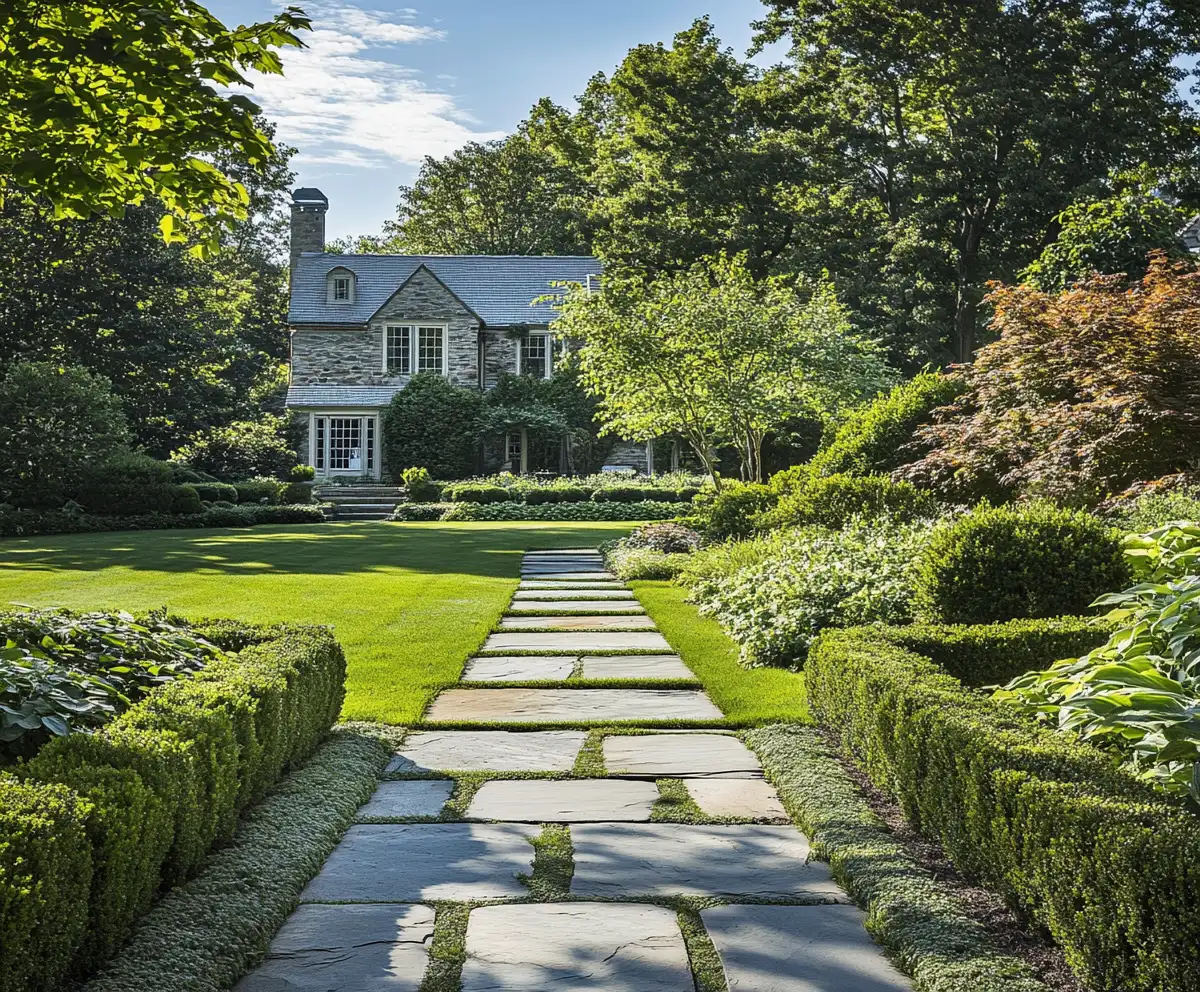Flagstone walkway design is more than functional—it’s a chance to elevate your garden with charm and character. Whether you’re going for a rustic stone look or enhancing your front yard landscaping, the right flagstone path can tie your whole outdoor space together beautifully.
In this guide, we’ll walk through creative ideas that blend practicality with beauty. Whether you want a tranquil garden retreat or a bold, eye-catching entrance, each of these concepts will help you transform your outdoor space into a welcoming, walkable masterpiece.
Table of Contents
1. Embrace the Organic Flow
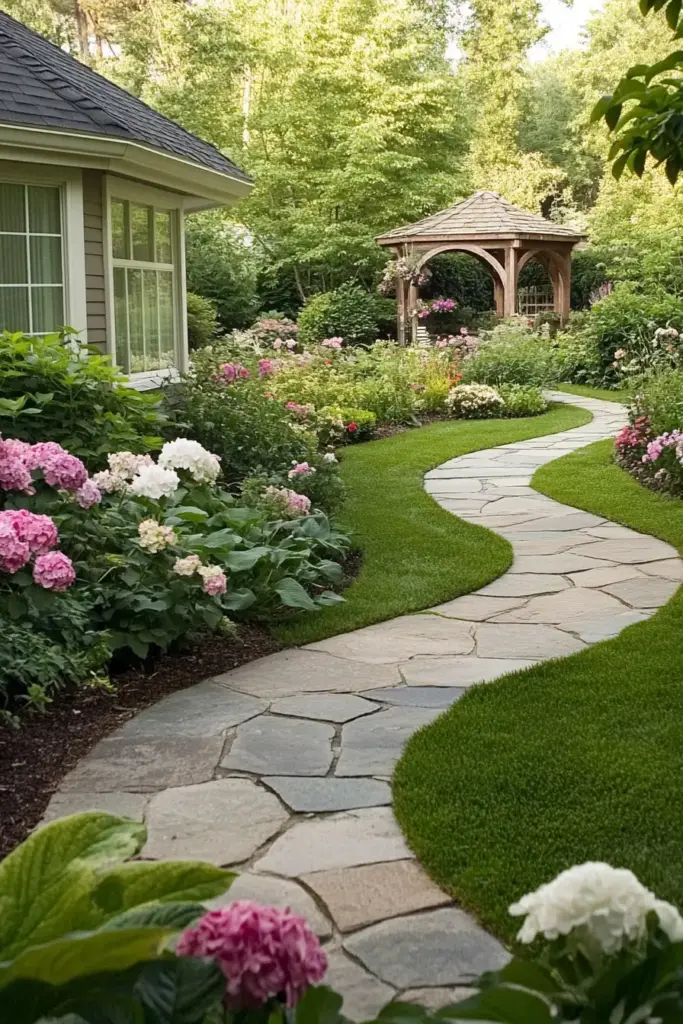
A flagstone walkway doesn’t need to be rigid or linear to make an impact. In fact, one of the most beautiful aspects of flagstone is how naturally it complements flowing lines and irregular shapes. Designing your path with a gentle, curved route not only adds visual interest but also invites guests to slow down and enjoy the journey through your garden.
Start by outlining the shape with a rope or garden hose to visualize how the walkway will meander through your yard. Place the flagstones in an offset pattern, allowing enough room between stones for a comfortable stride. Avoid straight lines—curved paths create a soft, natural movement that mimics the feel of a woodland trail or an old-world garden lane.
This organic style suits both large and small yards. For smaller spaces, even a slight curve gives the illusion of depth and intrigue. Let the landscape guide you: bend around trees, weave between shrubs, and follow the garden’s natural contours. When thoughtfully planned, a flagstone walkway becomes a calm, guiding presence—never rushed, always inviting.
2. A Patchwork of Colors
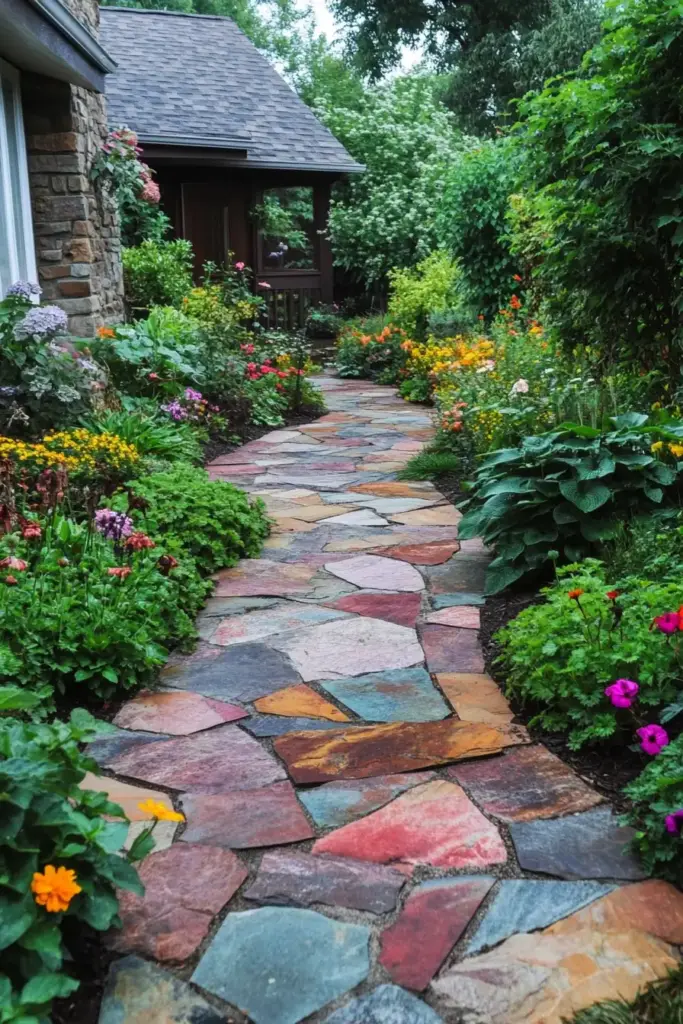
A flagstone walkway doesn’t have to be subtle to be stunning. One of the easiest ways to elevate its appeal is by introducing a vibrant mix of colors. Instead of choosing just one type of stone, consider blending a variety like warm-toned sandstone, cool slate, and creamy limestone to create a mosaic of earthy hues right at your feet.
Colorful flagstone walkways bring a dynamic, cheerful energy to your front yard. They reflect sunlight differently throughout the day and complement the changing tones of your surrounding plants. To ensure visual harmony, pick stones that echo existing colors in your home’s exterior or your favorite flower beds.
Spacing and placement matter too—aim for a layout that feels balanced, not busy. Mix large and small stones in irregular patterns to keep the look grounded and natural. Whether you’re going for something bold or more muted, a patchwork path can become a true focal point that enhances your garden’s character with every step.
3. The Stepping Stone Effect!
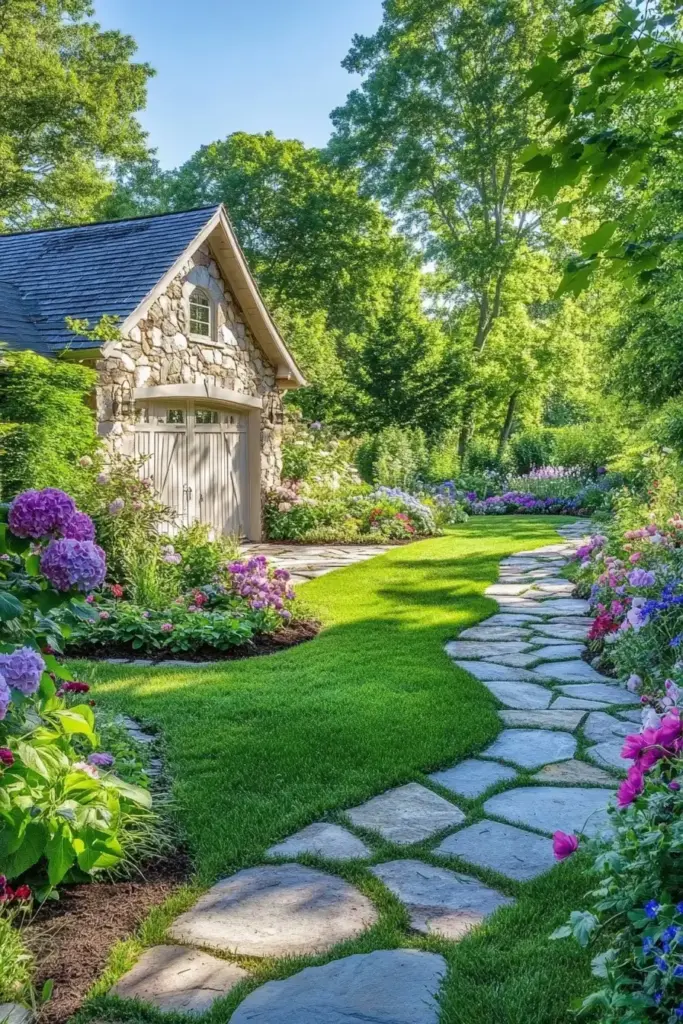
Sometimes, less is more—and a simple flagstone walkway made of spaced stepping stones can offer both charm and practicality. This design is especially appealing for informal gardens or family-friendly spaces where a bit of whimsy goes a long way.
Stepping stones embedded in grass or groundcover create a relaxed, open feel. Each stone feels like a gentle invitation: will you walk, hop, or wander today? This layout is ideal for those who want to soften hardscaping while maintaining a clear, walkable path.
To get it right:
- Space the stones based on natural stride length
- Use irregular shapes for a playful, organic look
- Fill the gaps with thyme, moss, or creeping sedum for color and texture
Not only does this setup look great, but it also allows water to drain naturally and keeps your lawn intact. Whether guiding visitors from driveway to porch or creating a meandering route through your garden beds, the stepping stone effect adds motion and mood to your yard without overwhelming it.
4. Mix and Match Textures for a Truly Tactile Walkway Experience
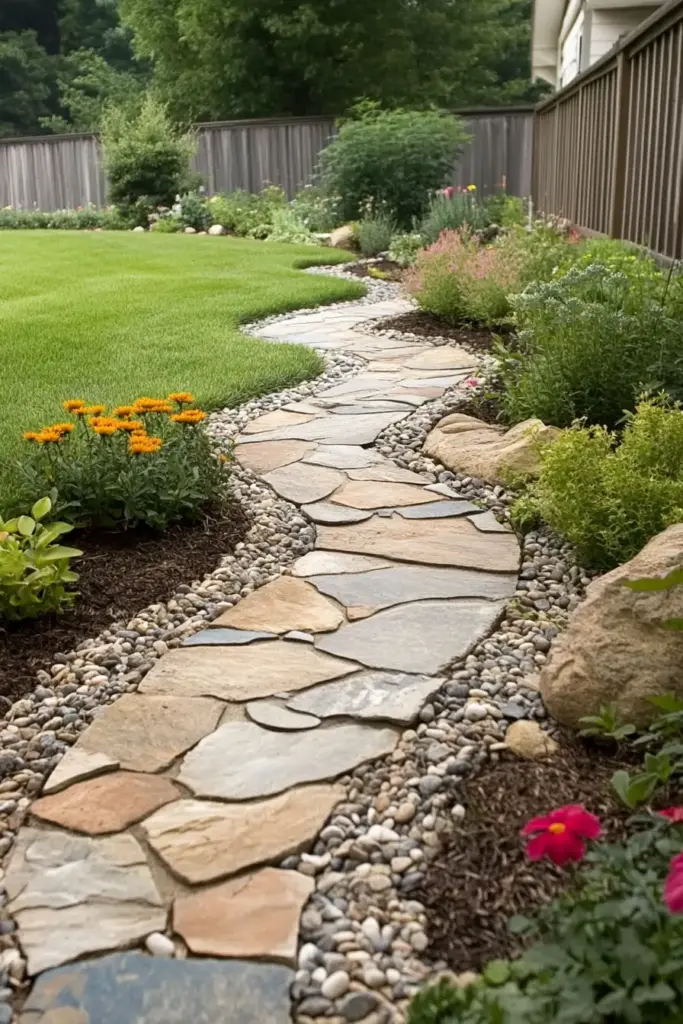
A flagstone walkway doesn’t just have to look beautiful—it can feel beautiful, too. By combining different materials like flagstone, gravel, bark chips, or even smooth river rocks, you add texture that engages the senses with every step.
Mixing materials isn’t just an artistic choice—it also serves practical purposes. Gravel adds a satisfying crunch underfoot and improves drainage. Smooth flagstones offer solid footing. When paired together, these materials can define zones within your walkway: transitions between a seating area and garden bed, or from a sunny lawn to a shady retreat.
Here’s how to layer texture effectively:
- Use gravel borders to frame your flagstone layout
- Alternate stone types and finishes—rough next to smooth
- Integrate mulch or bark in side paths for a natural break
The result is a walkway that’s both visually rich and sensorially rewarding. Whether you’re walking barefoot or hosting guests, every footfall becomes a small moment of connection with your landscape.
5. Glow at Every Step
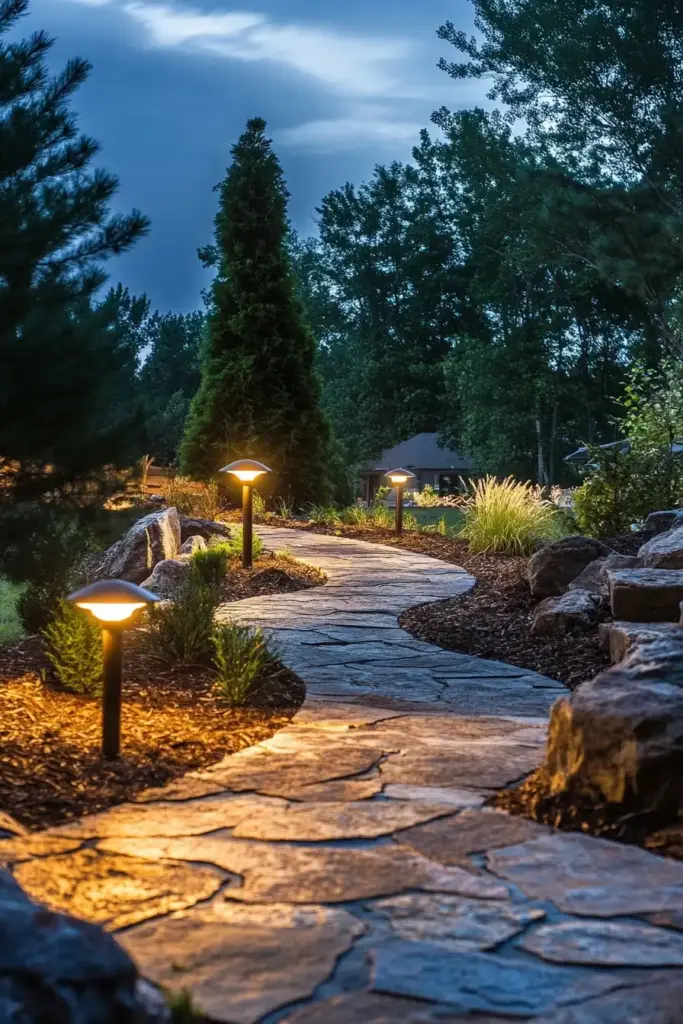
A flagstone walkway can be just as magical at night as it is during the day—if you light it right. Thoughtful illumination not only boosts safety but also creates a warm, inviting ambiance that enhances your front yard’s charm long after sunset.
There’s no need for harsh floodlights. Instead, aim for soft, low lighting that highlights the path’s edges and textures. Here are a few popular options:
- In-ground LED lights: Subtle and sleek, they outline stones without clutter
- Solar lanterns: Eco-friendly and easy to install—great for a rustic or cottage-style garden
- String or fairy lights: Weave through low shrubs or trellises nearby for a dreamy effect
Lighting is the finishing touch that turns a walkway into a true experience. It encourages evening strolls, makes guests feel welcome, and shows off the stone’s natural beauty after dark. Think of it like setting the mood for a twilight garden escape—peaceful, elegant, and glowing with intention.
6. Invite Solitude: Let Your Walkway Lead to a Secret Sanctuary
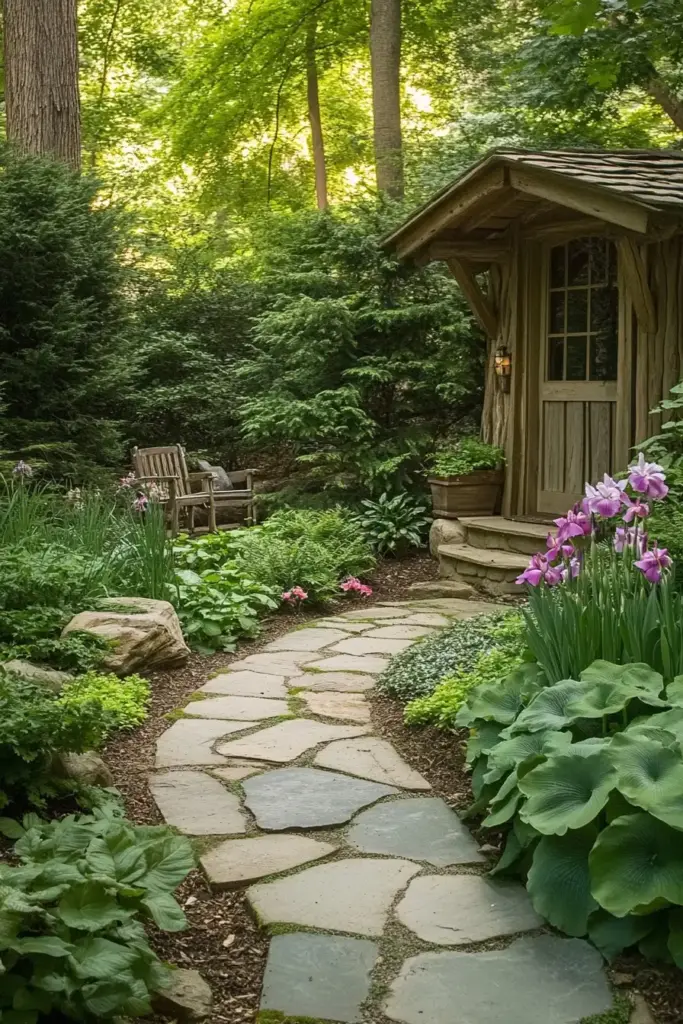
A well-planned flagstone walkway can do more than guide guests—it can lead you to peace. By curving your path toward a hidden nook or quiet seating area, you create a sense of discovery that adds depth and serenity to your front yard.
Think beyond the sidewalk-to-door layout. Instead, let your walkway wind toward a tucked-away bench, a shady reading spot, or a meditation corner wrapped in greenery. Choose plants that add softness and privacy, like climbing jasmine, dwarf evergreens, or layered grasses.
Here are a few tips to build your own personal retreat:
- Curve the path slightly out of sight to spark curiosity
- Use taller shrubs or container plants to create gentle “walls”
- Add a cozy chair, a birdbath, or a lantern for ambiance
This design idea turns your walkway into more than just a means to an end—it becomes an invitation to pause, breathe, and enjoy your garden in solitude. Sometimes, the best destination is the one just a few quiet steps away.
7. Making Your Walkway Pop: The Secret of Artistic Joints
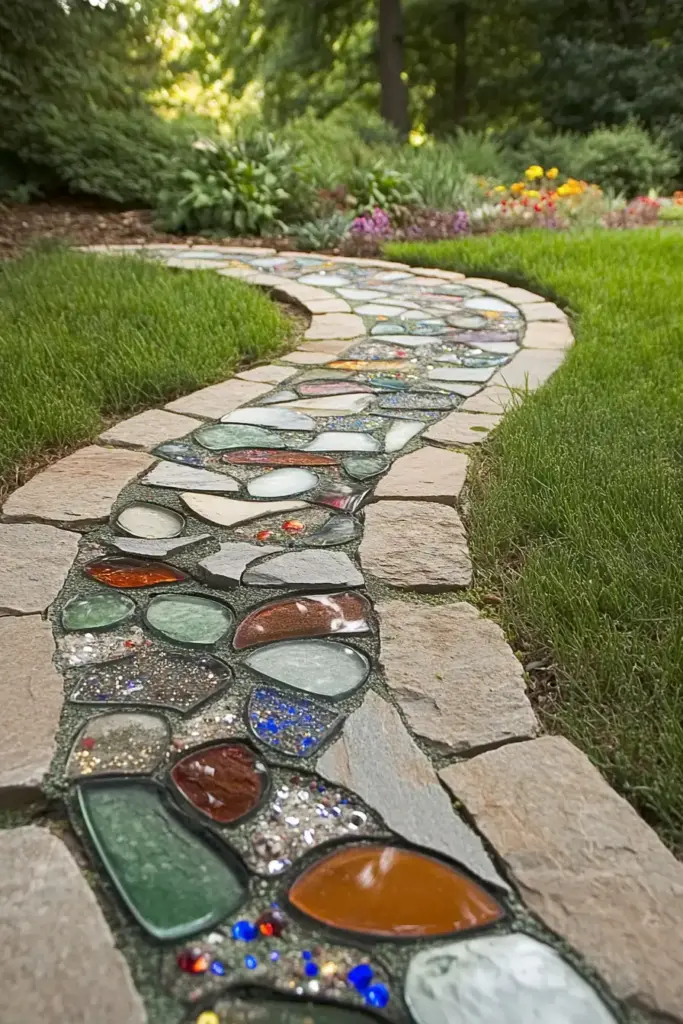
The space between stones in a flagstone walkway often goes unnoticed—but it’s actually one of the best places to add personality. These “joints” offer a perfect canvas for creativity, helping your path stand out with just a few thoughtful choices.
Instead of defaulting to plain sand or mortar, consider using materials that complement your landscape or add unexpected color and texture. Here are a few standout joint-fill options:
- Colorful polished pebbles – playful and vibrant
- Crushed glass – reflective and modern, especially in sunlight
- Low-growing herbs – like thyme or Irish moss for a soft, living touch
These small details don’t just make your walkway look custom—they also bring a tactile and visual contrast that elevates the entire design. Plus, some fillers like creeping plants release a gentle scent when stepped on, turning each walk into a multi-sensory experience.
Think of it like signing your name at the end of a painting—tiny touches that say, this path is mine.
8. Snack as You Stroll?
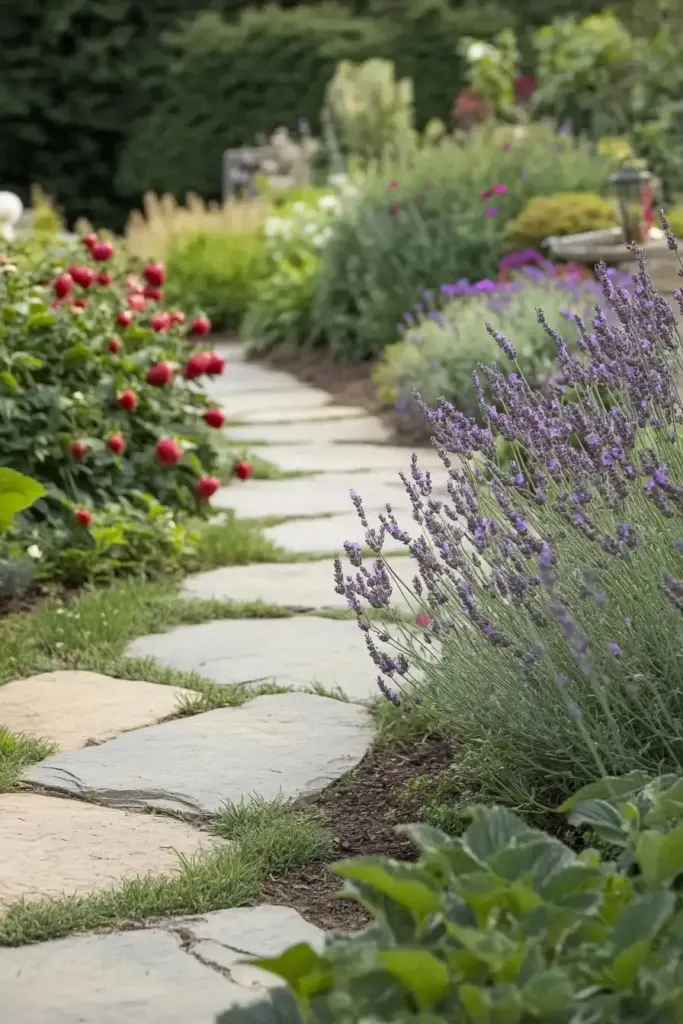
Why not make your flagstone walkway both beautiful and edible? Incorporating herbs and small fruiting plants along your path adds a layer of delight—letting you enjoy a little taste of your garden as you walk through it.
Imagine brushing against rosemary or mint, catching their aroma, and pinching a few leaves for dinner. Or perhaps you’ll find strawberries, alpine berries, or cherry tomatoes peeking through the greenery. It’s a functional way to bring life to your walkway, especially if you enjoy gardening with purpose.
To get started:
- Plant herbs like oregano, basil, or creeping thyme in the joints or along the edges
- Choose compact berry varieties that won’t overtake the walkway
- Consider raised borders with leafy greens like kale or rainbow chard for a splash of color
This edible design not only adds flavor to your landscape but also encourages interaction with your garden. It’s perfect for kids, cooks, and anyone who believes a great path should be as nourishing as it is lovely.
9. Turn Every Step Into a Moment: The Magic of Garden Art
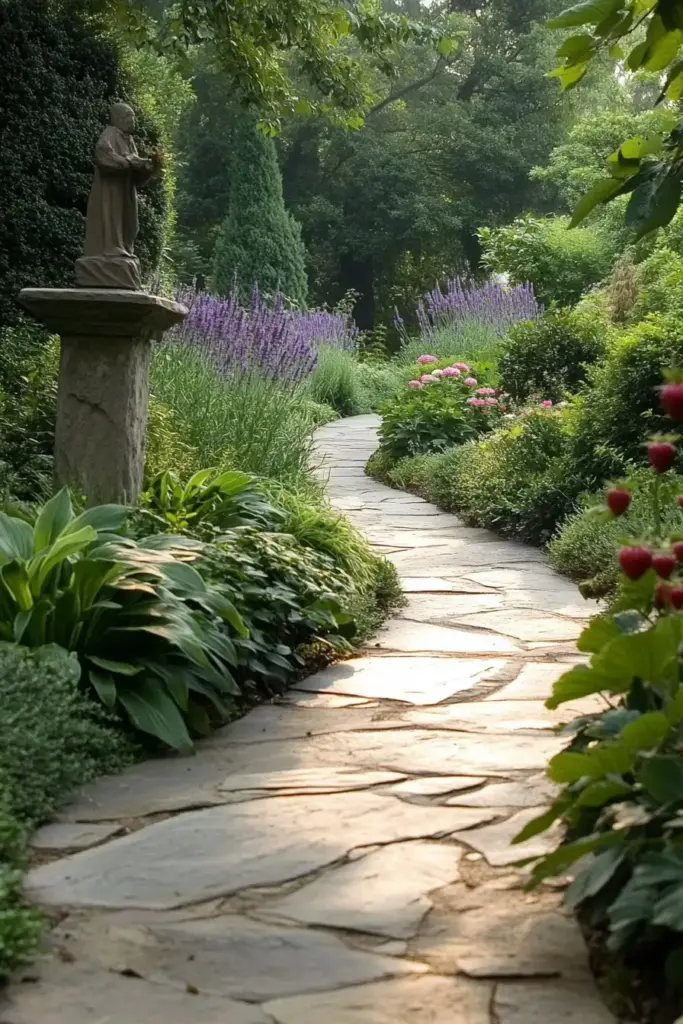
A flagstone walkway isn’t just about reaching a destination—it’s about the journey. Adding artistic elements along the path can transform a simple stroll into an experience filled with visual interest, surprise, and personal expression.
Garden art doesn’t have to be elaborate or expensive. The goal is to create moments of pause and wonder. A small sculpture tucked beneath a tree, a weathered urn placed at a curve, or a handcrafted mosaic stepping stone can all add soul to your landscape.
Here are a few ideas that blend beautifully with flagstone paths:
- Mosaic spheres or tile inlays between stones
- Whimsical sculptures or bird figurines nestled near focal points
- Custom planters or ceramic orbs placed strategically along the edges
These elements help set the tone of your garden—whether playful, serene, or bold. When art and nature come together, each step feels intentional, and your walkway becomes more than functional—it becomes meaningful.
10. Symmetrical Elegance
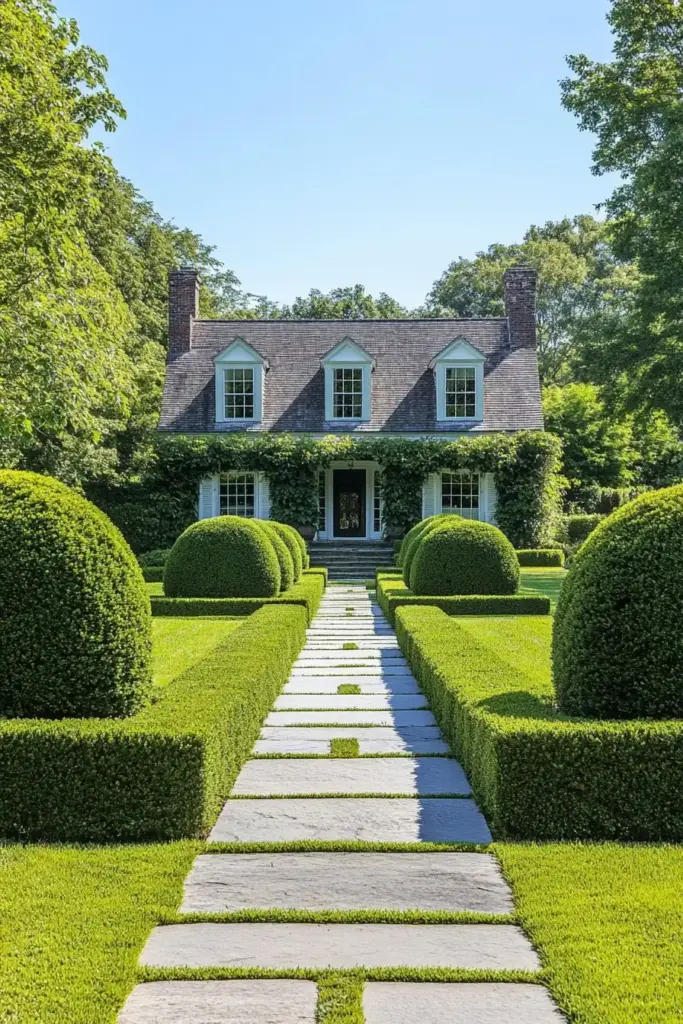
If you lean toward structure and formality, a flagstone walkway designed with symmetry might be your ideal match. There’s something timeless and satisfying about a balanced layout—where each stone on one side mirrors the other, creating a visual rhythm that draws the eye forward.
Symmetry is especially striking in front yards with traditional architecture or formal gardens. It establishes a sense of order and grandeur, making your entrance feel deliberate and refined. Start by marking a centerline using string and stakes, then lay flagstones outward in mirrored pairs, adjusting for balance as you go.
To elevate the elegance:
- Line the walkway with clipped boxwoods, ornamental grasses, or matching flower beds
- Frame the path with stone or brick edging for crisp definition
- Use large, uniform flagstones for a clean, polished finish
This design doesn’t have to be rigid—it can still feel warm and welcoming. A symmetrical flagstone walkway sends a clear message: this space is cared for, and beauty lives in the details.
11. Add a Little Illumination
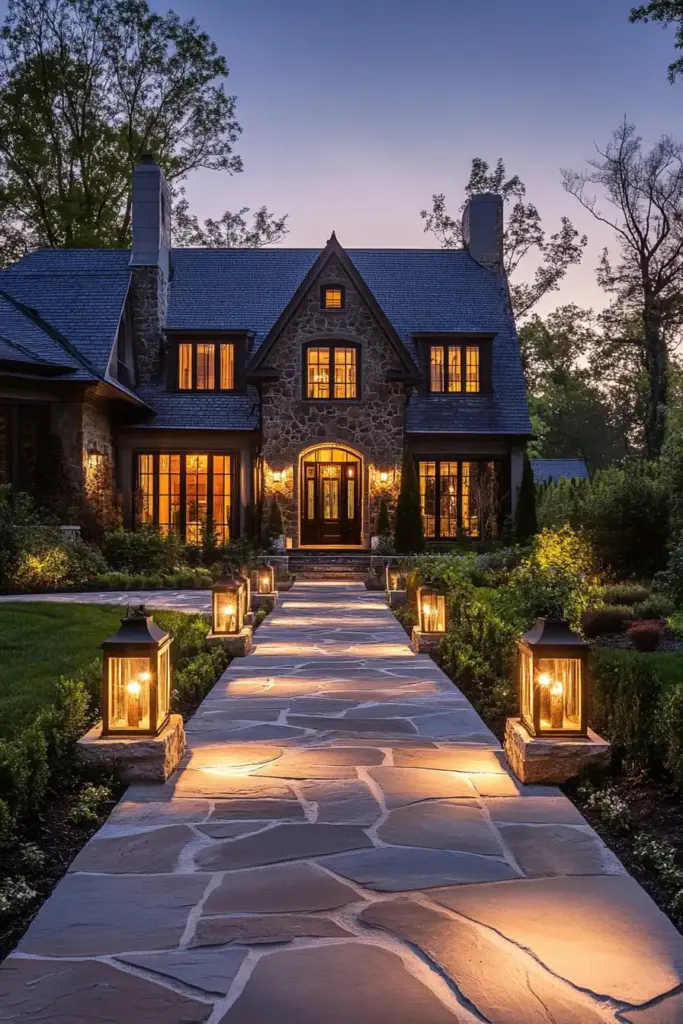
A thoughtfully lit flagstone walkway offers more than visibility—it creates atmosphere. Whether you’re welcoming guests after sunset or enjoying a quiet evening stroll, the right lighting brings your garden to life at night.
Soft, subtle lighting enhances the texture of the stones and draws attention to surrounding plants without overwhelming the scene. You don’t need an electrician to get started—many lighting options today are low-maintenance and solar-powered.
Popular ways to illuminate your path:
- Solar stake lights placed along both edges for consistent glow
- Downlights on nearby trees or posts to mimic moonlight
- Lantern-style fixtures for an old-world touch
- In-ground LEDs embedded beside stones for a sleek, modern vibe
Not only does lighting improve safety and usability after dark, but it also highlights your hardscape investment and adds charm around the clock. With the right glow, even a quiet walkway can feel like a warm welcome home.
12. How Water Features Breathe Life Into Stone Walkways
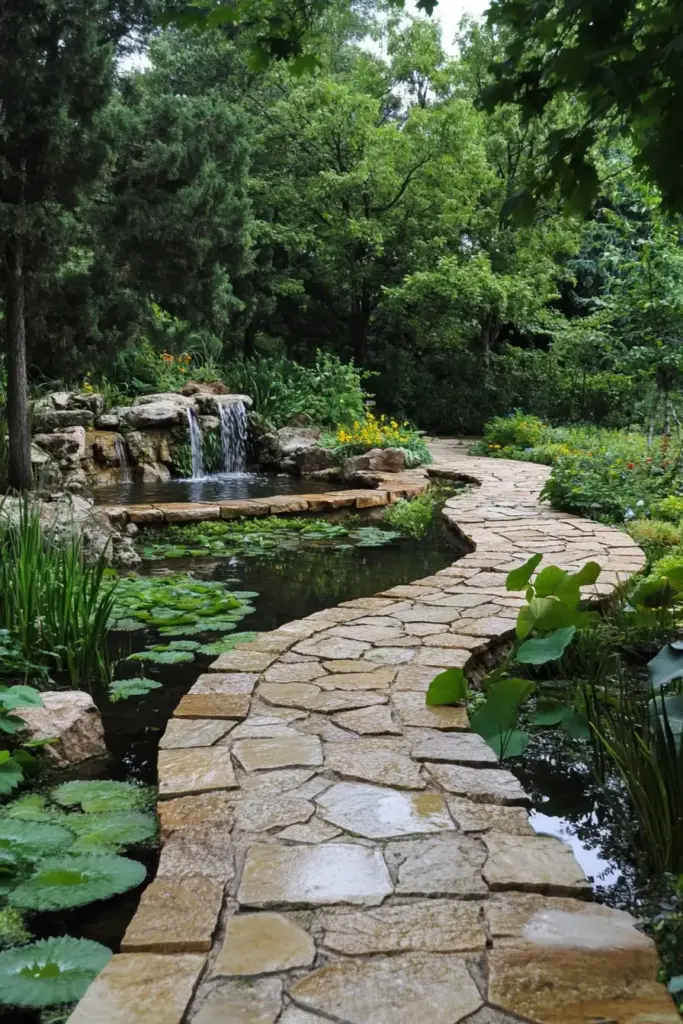
Pairing a flagstone walkway with the gentle sound of water is one of the most effective ways to turn your front yard into a sanctuary. The combination of stone underfoot and water nearby creates a calming, immersive atmosphere that soothes both the eyes and ears.
Even small water features can make a big impact. You don’t need a large pond or elaborate system—just a trickling fountain or bubbling birdbath can add movement and tranquility.
Here are a few ideas to consider:
- A small stream or rill that winds alongside the flagstone path
- A pond with aquatic plants, edged with river rock for a natural transition
- A tiered fountain near the walkway entrance for an elegant first impression
- A simple wall spout that spills water into a stone basin
Water features not only enhance visual appeal but also invite birds, butterflies, and beneficial insects. It’s a living, breathing element that brings motion to your hardscape—and a peaceful pause to your day.
13. Rustic Charm, Natural Edges
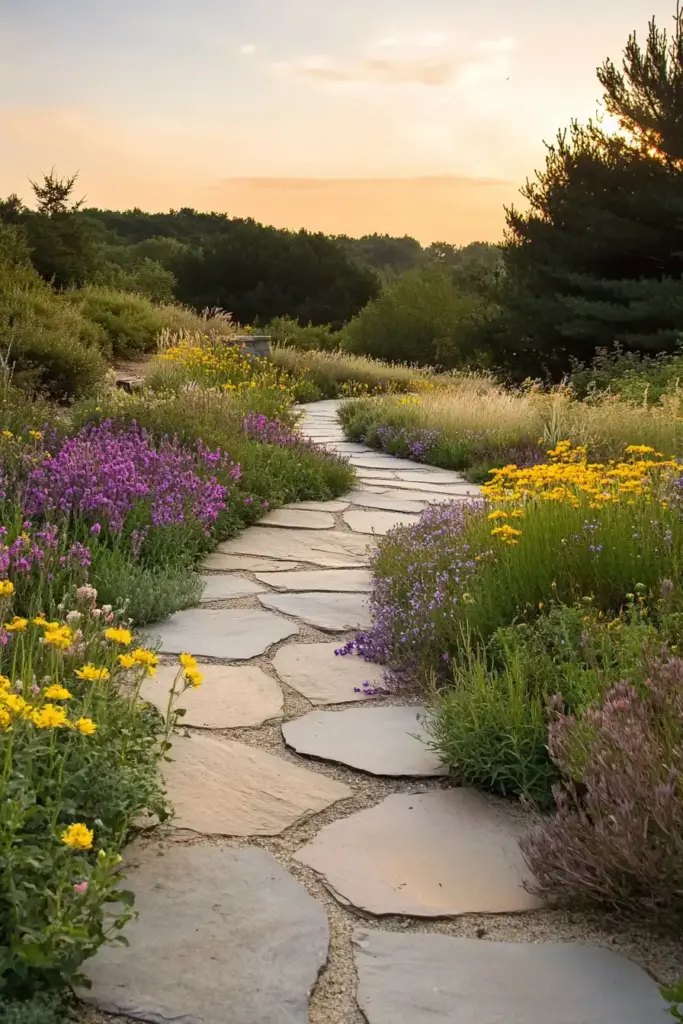
If your style leans toward earthy and unrefined, then a flagstone walkway with natural edges is the perfect match. Unlike cut or geometric stones, naturally shaped flagstones celebrate the raw, rugged beauty of stone—each piece unique in texture, contour, and character.
This rustic approach creates a sense of authenticity. It feels like the path was uncovered, not built—like it’s always been part of the land. That effortless look takes intention, but it’s well worth the result.
To enhance that rustic charm:
- Choose irregular stones with visible grains and raw outlines
- Leave space between stones for grass or moss to peek through
- Use reclaimed or locally sourced stone for added story and sustainability
Natural edges blur the line between walkway and landscape, helping your hardscape blend seamlessly into its surroundings. The imperfections become features, and the result is a path that feels honest, grounded, and wonderfully human.
14. Layer with Lush Greenery
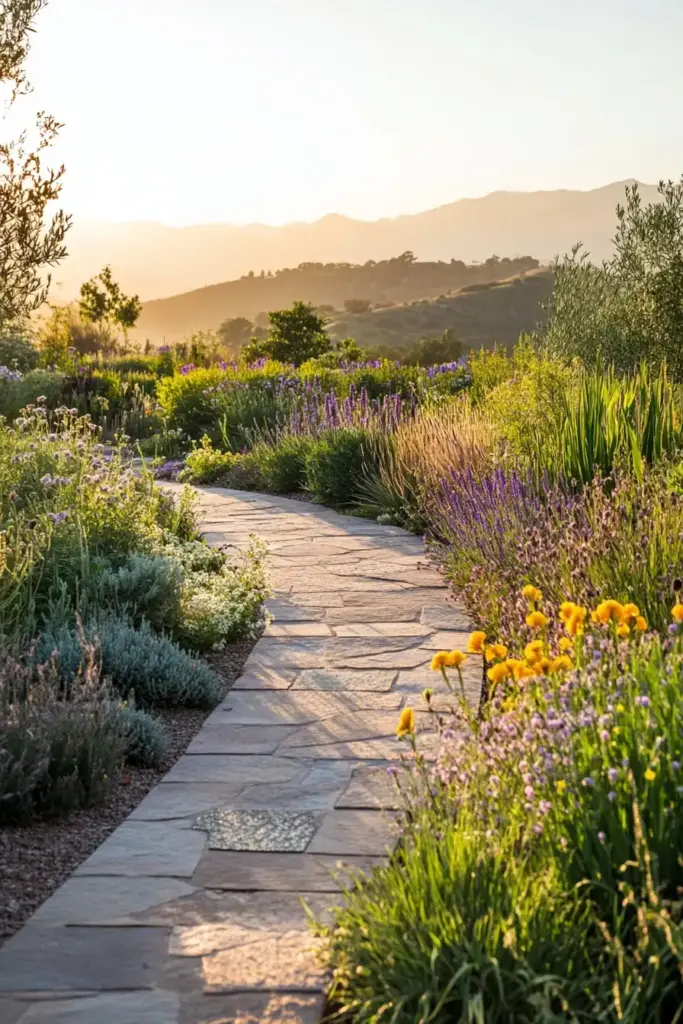
Few things complement a flagstone walkway better than the softness of lush, layered greenery. Plants help frame the path, draw attention to its curves, and create a seamless connection between hardscape and garden.
Layering is the key to making your walkway feel alive and dynamic. Use a mix of heights, textures, and tones to give the space depth and natural rhythm. Let greenery spill gently over the edges, softening the hard lines of the stone and inviting you in.
Planting tips for a lush look:
- Use low growers like creeping Jenny or sweet alyssum along the path’s edge
- Tuck in medium-height plants like ferns or hostas for mid-level interest
- Add taller accents—such as ornamental grasses or flowering perennials—at curves or corners
This layered approach adds movement and color throughout the seasons, while still allowing your flagstone to remain the star. The result is a walkway that feels like it’s been woven into the landscape—not simply laid on top of it.
15. Seamless Plant Integration
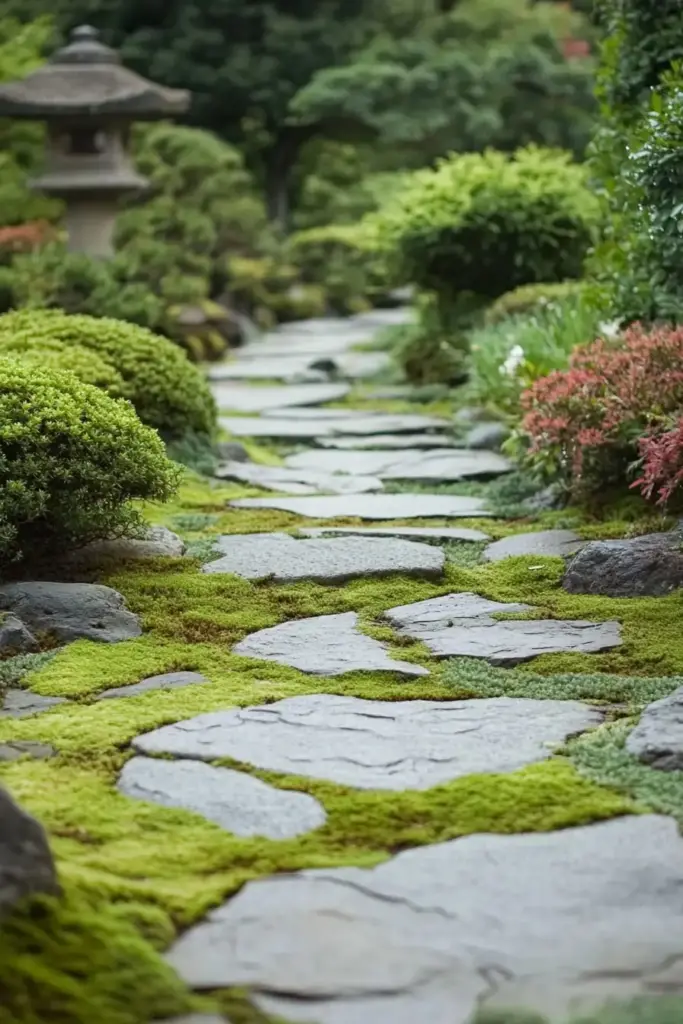
One of the most charming ways to enhance a flagstone walkway is to let plants grow between the stones, not just beside them. When done well, this technique creates a soft, seamless transition from path to garden, blending hardscape and greenery into one cohesive experience.
Rather than using concrete or gravel to fill the joints, consider low-growing, foot-friendly plants that add texture, color, and even fragrance.
Top choices for seamless integration include:
- Moss – perfect for shady spots, offering a rich, velvety green
- Creeping thyme – drought-tolerant, aromatic, and blooms with tiny purple flowers
- Dwarf mondo grass – adds deep green contrast and thrives in narrow gaps
These living joints do more than look good—they cool the stone, cushion footfalls, and attract pollinators. Plus, they’re an easy way to reduce runoff and support soil health.
The goal is to blur the line between walkway and garden until every step feels like part of a living, breathing landscape.
16. Flagstone with a Woodland Twist: What’s the Secret?
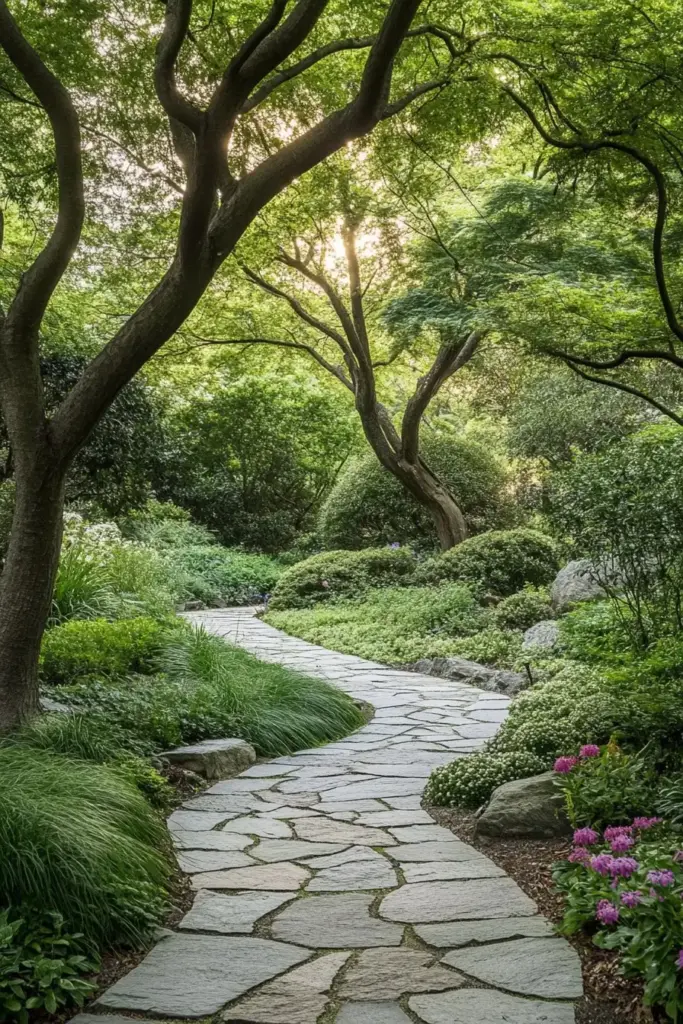
A flagstone walkway can feel like a forest trail when paired with the right plants and layout. This woodland-inspired design leans into nature’s palette—irregular stones, soft undergrowth, and dappled light—to create a path that feels peaceful, untouched, and timeless.
To achieve the woodland look, focus on native and shade-loving plants that thrive in filtered light and moist soil. Think texture over color, and layers over formality.
Here’s how to create your own woodland twist:
- Line your path with ferns, wild violets, and Solomon’s seal
- Use mossy or weathered flagstone for an aged, organic feel
- Incorporate small trees or understory shrubs like dogwoods or serviceberry
- Allow the path to gently curve and narrow for mystery and intimacy
This style is ideal for front yards shaded by large trees or nestled into natural slopes. The result? A flagstone walkway that feels like it was lifted from a storybook—quiet, grounding, and deeply connected to the land.
17. Dare to Design: Crafting Your Own Mosaic Walkway
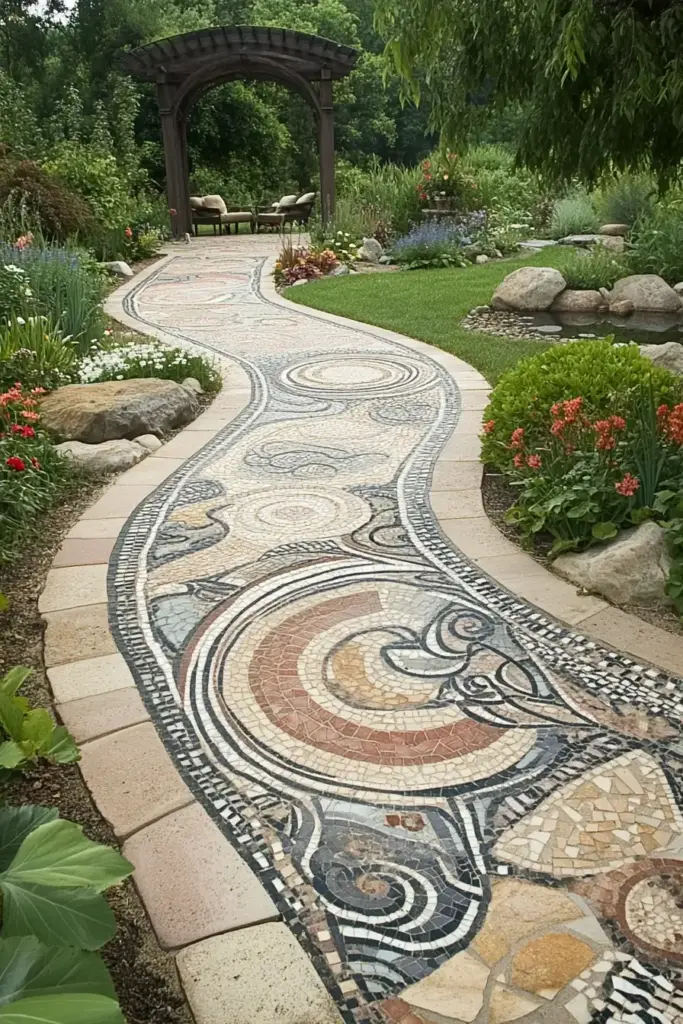
If you’re feeling artistic, why not turn your flagstone walkway into a masterpiece? A mosaic design lets you blend different colors, shapes, and sizes of stone into a patterned path that reflects your personality and creativity.
Unlike traditional walkways, mosaic paths celebrate irregularity. You don’t need a perfect plan—just a general layout and a willingness to experiment. Think of it as a puzzle where you get to decide what the picture looks like.
Tips for a successful mosaic-style walkway:
- Sketch a rough design on paper to guide layout and focal points
- Mix contrasting stone colors to create depth and variation
- Use larger stones as anchors and fill in with smaller pieces for flow
- Incorporate curves or repeating shapes to keep the design cohesive
Whether abstract or symbolic, a mosaic path makes your landscape unforgettable. It becomes not just a place to walk, but a piece of garden art that tells a story with every step.
18. Flagstone Meets Gravel: Effortless Style, Brilliant Function
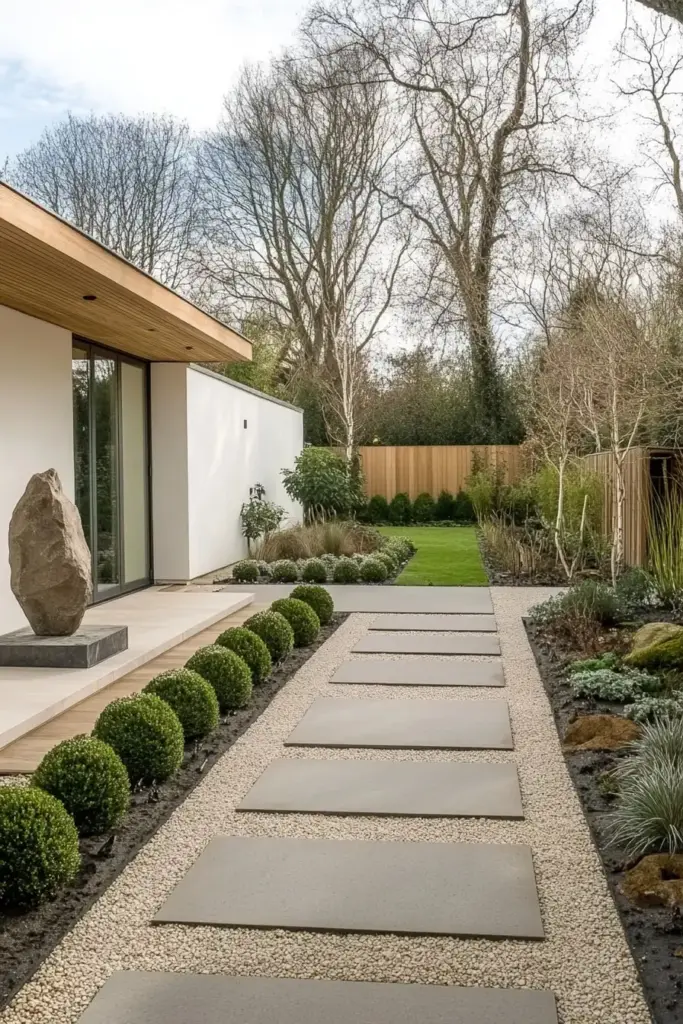
Blending gravel with a flagstone walkway creates a design that’s as smart as it is stylish. This pairing brings together the sturdy, timeless look of stone with the versatility and practicality of gravel—offering excellent drainage, easy installation, and a relaxed, modern aesthetic.
This combination is perfect for homeowners who want a low-maintenance path that still feels elegant. Gravel fills the gaps between flagstones, preventing weeds, reducing erosion, and allowing rainwater to filter naturally into the ground.
To pull it off effectively:
- Use fine pea gravel or decomposed granite for smoother footing
- Lay flagstones in irregular or staggered patterns for visual interest
- Compact the gravel base well to stabilize each stone
- Edge the walkway with metal, brick, or wood to keep the gravel in place
This look works in both contemporary and cottage-style gardens. It’s informal yet polished—and a great option for busy households or climates with heavy rain. In short, it’s beauty and function, effortlessly combined.
19. Formal Gardens with Flagstone
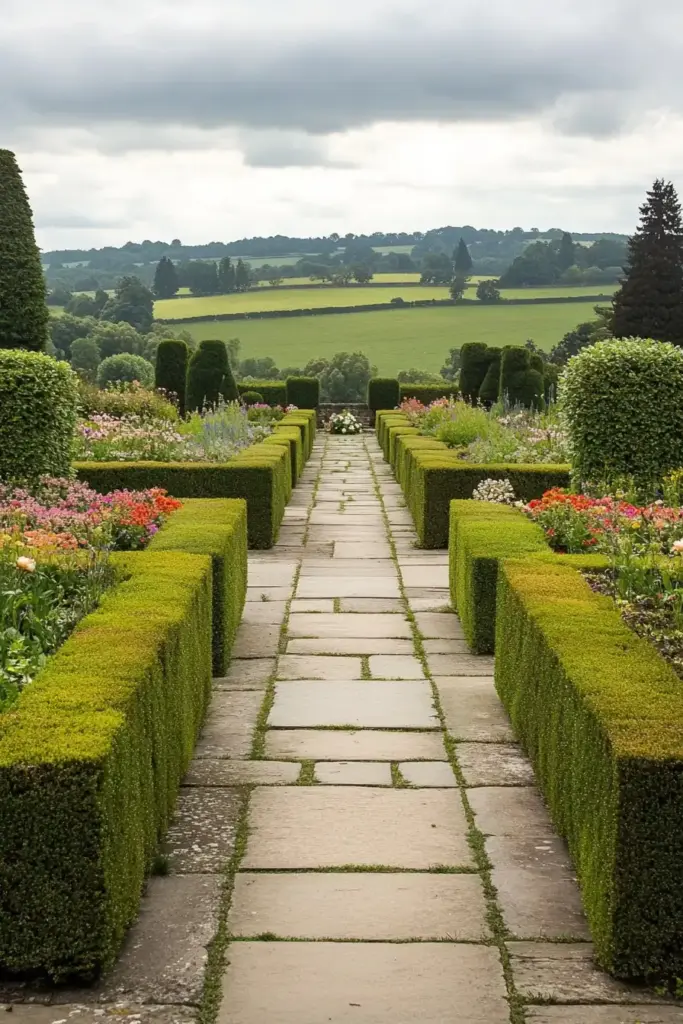
A flagstone walkway can be the perfect centerpiece in a formal garden, where order, symmetry, and structure take the lead. In these spaces, every element feels intentional—and the walkway becomes a guiding line that anchors the design.
To match this classic aesthetic, use cut or evenly shaped flagstones laid in straight or patterned rows. Clean lines, repetition, and proportion are key. The goal is to create a sense of calm precision that draws the eye and frames your plantings.
Design ideas for a formal flagstone walkway:
- Flank the path with mirror-image flower beds or clipped boxwood hedges
- Choose uniform stone sizes and arrange them in grids or offset brick-style layouts
- Add symmetrical focal points—like urns, statues, or topiary at the walkway’s end
- Use a central axis to guide alignment for a balanced and polished look
With the right layout and accents, a formal flagstone path turns your front yard into an elegant, event-worthy space—ideal for those who love structure, sophistication, and a timeless garden vibe.
20. Bold Borders for Definition
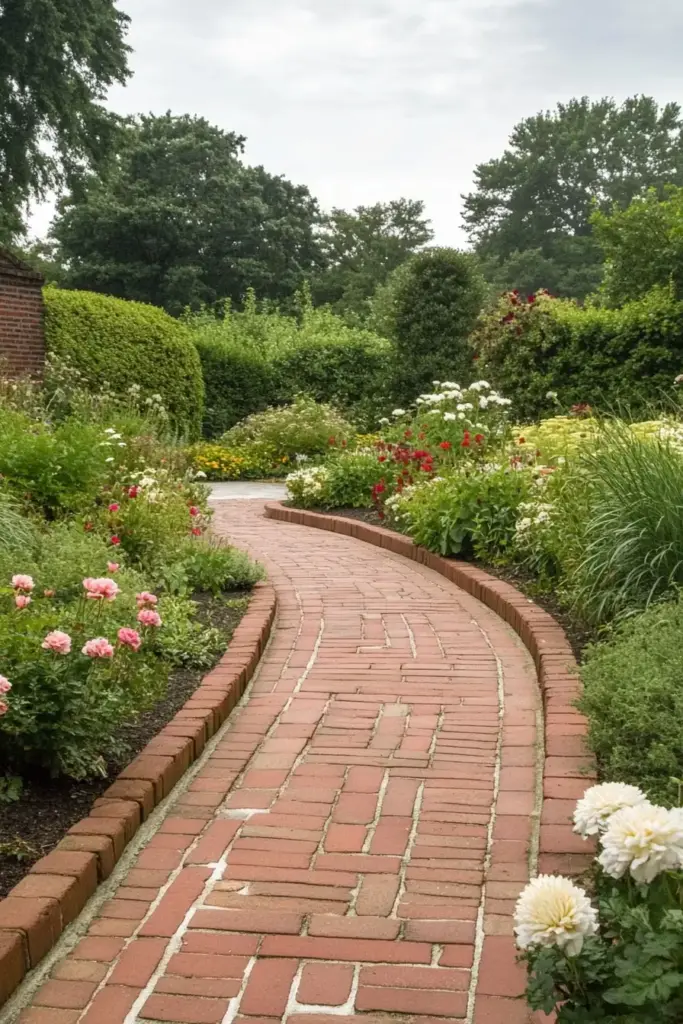
Every great flagstone walkway deserves a strong frame. Adding bold borders not only sharpens the visual appeal but also helps contain materials, define the path, and add structure to your overall garden design.
Borders act like picture frames for your path—guiding the eye and providing a polished finish. Whether you want a rustic edge or a crisp, modern look, the right border makes all the difference.
Popular border choices include:
- Bricks – timeless, warm, and great for symmetry
- River stones – organic and smooth, ideal for cottage or woodland styles
- Metal edging – sleek, durable, and nearly invisible from a distance
- Wood timbers – great for a natural or rustic effect
Your border doesn’t have to match your flagstones exactly, but it should complement their color and style. And don’t forget function—good edging keeps gravel and plants in place, reducing maintenance over time.
Well-defined edges give your walkway clarity and presence, turning it from a simple path into a standout garden feature.
Conclusion
A well-designed flagstone walkway is more than just a functional path—it’s a creative statement that reflects your style, mood, and outdoor personality. Whether you’re drawn to the wild charm of natural landscaping with rocks, the structured elegance of formal garden layouts, or the playful magic of whimsical garden decor, flagstone offers versatility that fits any landscape vision.
From planting fragrant herbs along the edges to incorporating mosaic garden art or even pairing your path with a lush flower bed, each idea adds richness and meaning to your yard. Thoughtful choices in texture, layout, and plant pairing can turn even the shortest path into a memorable garden journey.
Let your front yard landscaping tell a story—one that begins at the first step and continues with every stroll.

